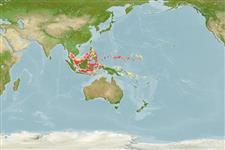>
Eupercaria/misc (Various families in series Eupercaria) >
Labridae (Wrasses) > Cheilininae
Etymology: Cirrhilabrus: Latin, cirrus = curl fringe + Greek, labros = furious (Ref. 45335); earlei: Named in honor of John L. Earle who collected the holotype..
More on authors: Randall & Pyle.
Environment: milieu / climate zone / depth range / distribution range
Ökologie
seewasser riff-verbunden; tiefenbereich 60 - 110 m (Ref. 41654). Tropical
Western Central Pacific: Palau and Micronesia.
Length at first maturity / Size / Gewicht / Alter
Maturity: Lm ?, range 5 - ? cm
Max length : 6.9 cm SL Männchen/unbestimmt; (Ref. 41654)
Kurzbeschreibung
Bestimmungsschlüssel | Morphologie | Morphometrie
Rückenflossenstacheln (insgesamt) : 11; Rückenflossenweichstrahlen (insgesamt) : 9; Afterflossenstacheln: 3; Afterflossenweichstrahlen: 9; Wirbelzahl: 25. This species is distinguished by the following characters: D XI,9; A III,9; pectoral fin rays 15; dorsal fin with progressively longer spine where the 11th is 2.4-2.6 in head; in males the interspinous membranes do not extend above the spine tips; pelvic fins of male short 4.05-4.9 in SL; rounded to rhomboid caudal fin; lateral line scales 16-17 + 5-6; median predorsal scales 4-5; cheeks with 2 horizontal rows of scales; colour in life pale red, shading to pale yellow on abdomen, with deep red longitudinal lines on body following scale rows (persists as lavender to purple when preserved); head with two deep pink bands, one from upper lip passing over eye to origin of dorsal fin, the other from lower lip along mandible to corner or preopercle; operculum yellow; dorsal fin yellow anteriorly with a black spot on first membrane, spines red; rest of fin and caudal fin light red with deep red rays; pelvic fins yellow with red spines and rays (Ref. 41654).
Inhabits mixed coral, rubble, and sand slopes along the bases of steep protected seaward reefs (Ref. 37816). Maximum depth reported taken from Ref. 128797.
Life cycle and mating behavior
Maturities | Fortpflanzung | Spawnings | Egg(s) | Fecundities | Larven
Distinct pairing during breeding (Ref. 205).
Randall, J.E. and R.L. Pyle, 2001. Three new species of labrid fishes of the genus Cirrhilabrus from islands of the tropical Pacific. aqua, J. Ichthyol. Aquat. Biol. 4(3):89-98. (Ref. 41654)
IUCN Rote Liste Status (Ref. 130435)
Bedrohung für Menschen
Harmless
Nutzung durch Menschen
Tools
Zusatzinformationen
Download XML
Internet Quellen
Estimates based on models
Preferred temperature (Ref.
123201): 12.6 - 28.5, mean 23 °C (based on 8 cells).
Phylogenetic diversity index (Ref.
82804): PD
50 = 0.5000 [Uniqueness, from 0.5 = low to 2.0 = high].
Bayesian length-weight: a=0.01585 (0.00707 - 0.03555), b=2.95 (2.76 - 3.14), in cm total length, based on LWR estimates for this (Sub)family-body shape (Ref.
93245).
Trophic level (Ref.
69278): 3.3 ±0.4 se; based on size and trophs of closest relatives
Widerstandsfähigkeit (Ref.
120179): hoch, Verdopplung der Population dauert weniger als 15 Monate. (Preliminary K or Fecundity.).
Fishing Vulnerability (Ref.
59153): Low vulnerability (10 of 100).
